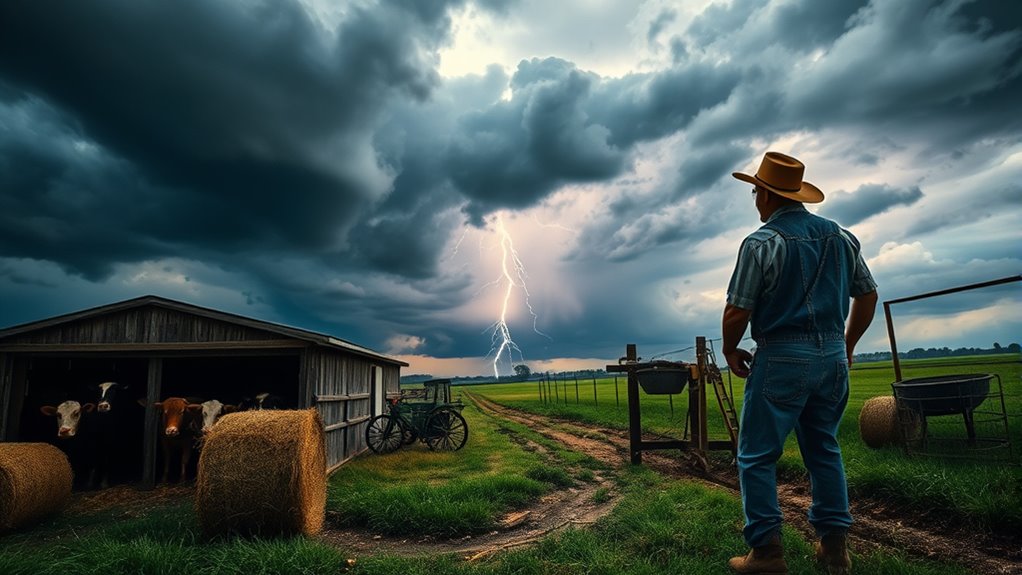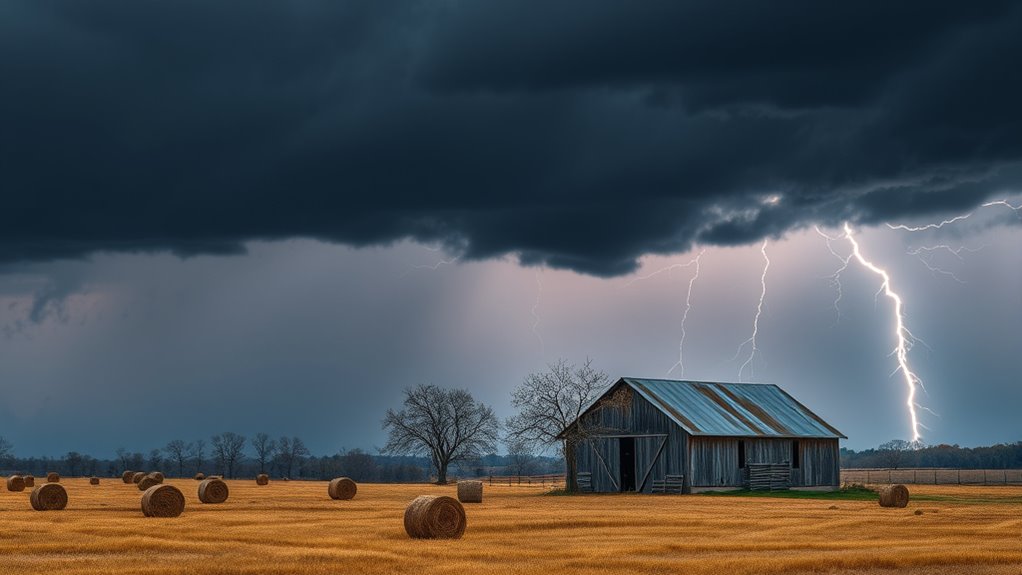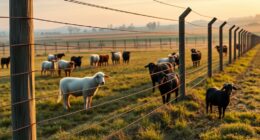To prepare for thunderstorms and lightning on your farm, establish a safety plan with designated shelters for people and animals. Install and regularly maintain lightning rods and grounding systems on buildings. Move livestock to safe shelters before storms hit, avoiding trees and conductive structures. Keep emergency supplies and communication tools ready, and conduct safety drills often. Knowing how to respond quickly can save lives and assets—continue to explore ways to enhance your farm’s storm safety measures.
Key Takeaways
- Establish a comprehensive storm safety plan with designated shelters for personnel and livestock.
- Install and routinely inspect lightning rods and grounding systems on all farm structures.
- Move animals and equipment to grounded, sturdy shelters before storms arrive.
- Maintain emergency supplies like first aid kits, flashlights, and reliable communication devices.
- Monitor weather updates regularly and conduct safety drills to ensure preparedness.

Are you prepared to protect your farm during thunderstorms? Thunderstorms can strike unexpectedly, bringing heavy rain, strong winds, and dangerous lightning. Ensuring storm safety isn’t just about safeguarding your crops and equipment; it’s about protecting yourself and everyone working on your farm. Implementing effective lightning protection measures and understanding how to respond during storms can make all the difference.
First, focus on establishing a thorough storm safety plan. Make sure everyone on your farm knows what to do when thunderstorms roll in. This includes identifying safe shelters and understanding the signs of an approaching storm. Keep an eye on weather updates through reliable sources and have a communication system in place to alert workers quickly. Good storm safety also involves training your team on emergency procedures, such as how to evacuate livestock or bring machinery to safe locations. Having a clear plan minimizes chaos and reduces the risk of injury or damage when lightning strikes.
Establish a storm safety plan with shelters, weather alerts, and emergency procedures for your farm.
Lightning protection should be a top priority on your farm. Installing lightning rods or grounding systems on barns, silos, and other essential structures helps redirect electrical energy safely into the ground, reducing the risk of fire or structural damage. These systems are especially crucial for buildings housing equipment or livestock, as they are common targets for lightning strikes. Regularly inspect and maintain your lightning protection setup to ensure it functions correctly. Remember, a well-grounded system can save your structures and lives during a storm.
Beyond physical protections, consider the placement of your equipment and livestock. Keep machinery and electrical wiring away from tall, isolated objects that might attract lightning. When a storm approaches, move livestock to designated safe shelters away from open fields and tall objects. Avoid taking shelter under trees, as lightning can strike them and cause injury or damage. Instead, seek sturdy, grounded buildings, or if no shelter is available, stay in a low-lying area away from tall structures or conductive materials.
Preparing for thunderstorms also means keeping emergency supplies handy. Stock up on first aid kits, flashlights, batteries, and other essentials. Develop a communication plan that includes informing workers about storm procedures and how to contact emergency services if needed. Regular drills help reinforce these safety measures, ensuring everyone knows their role. Additionally, understanding the importance of affiliate disclosures can help you stay informed about safety products that might be helpful during storm preparedness.
Frequently Asked Questions
How Can I Tell When a Thunderstorm Is Approaching?
You can tell a thunderstorm is approaching by watching for changes in cloud formation, such as dark, towering cumulonimbus clouds. Pay attention to wind patterns, which often pick up and shift direction as a storm nears. You might also notice a drop in temperature or an increase in humidity. These signs, combined with rapidly darkening skies, indicate that a thunderstorm is likely imminent and you should take precautions.
What Are the Best Emergency Shelters for Farm Animals?
Think of your farm animals as precious treasures needing protection. Your best emergency shelters are sturdy, well-ventilated structures built with animal safety in mind—like barnyards with solid walls, reinforced roofs, and clear exits. Proper shelter construction guarantees animals stay dry, safe, and calm during storms. Always keep these shelters accessible and ready, so when thunder roars, your animals find refuge quickly, minimizing stress and potential injuries.
How Do I Protect Electrical Equipment During Storms?
To protect electrical equipment during storms, you should guarantee your grounding systems are properly installed and maintained, which helps direct lightning strikes safely into the ground. Also, use surge protectors on all sensitive devices to prevent power surges from damaging them. Regularly inspect and update your grounding and surge protection systems, and unplug equipment when storms are imminent to minimize risk and ensure your farm’s electrical safety.
Are There Specific Signs of Lightning Strikes on Farms?
You’ll notice ground strike indications like scorched or cracked soil and damaged electrical equipment, which are signs of lightning damage. Lightning strikes can also leave behind burn marks or unusual odors on machinery and structures. Keep an eye out for discolored or melted wiring, as these are clear lightning damage signs. Recognizing these signs quickly helps you assess and address potential hazards, minimizing further damage and ensuring safety on your farm.
What Are the Long-Term Effects of Lightning on Farmland?
Lightning can cause long-term effects on your farmland, leading to soil degradation and crop damage. When lightning strikes, it can alter soil chemistry, reduce fertility, and create patches of less productive land. Additionally, crops may suffer from fires or shock, decreasing yields over time. To mitigate these impacts, consider implementing soil conservation practices and monitoring affected areas regularly, helping you maintain productive farmland despite lightning’s potential damage.
Conclusion
By staying vigilant and implementing these safety measures, you can protect both yourself and your livestock during thunderstorms. Some might think waiting it out is safe, but storms can quickly turn dangerous. Preparing ahead guarantees you’re not caught off guard and reduces risks of injury or loss. Remember, proactive steps foster peace of mind and safeguard your farm’s future, proving that a little planning now can prevent significant problems later. Stay alert, stay safe, and weather the storm confidently.










